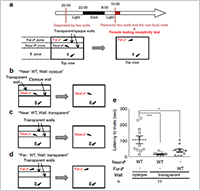Enlarge Image
Mate-guarding behaviour favours a familiar face
Okayama University researchers confirm the role of mate-guarding in males for blocking the female’s visual familiarity with rival males to improve mating success in a medaka fish model.
“Male-male competition and female mate choice are considered to be major constituents of mating strategies and many studies of these behaviors have been performed individually,” explain Hideaki Takeuchi at Okayama University and the University of Tokyo and his collaborators in Japan and the US in their report. Previously, this team reported that male medaka fish in a triangle relationship (two males and one female) hold a position between the rival male and a female, which results in improvement of mating success. However the significance of different effects from this mate-guarding behaviour –such as visual familiarity and apparent social dominance – had not previously been understood.
The researchers used a transparent aquarium split into 3 compartments with the female in the end compartment. Male and female fish were selected at random and stored in the compartments for around 12 hours overnight before being released to mate.
The enhanced female receptivity (the decreased latency to mate) with transparent walls versus opaque walls confirmed the importance of visual familiarity. The team also quantified the mate guarding behaviour of the near fish and confirmed that by blocking the far fish from view, they impeded the visual familiarization in the far fish. Mutant fish that have mate-guarding behaviour deficits did not inhibit the mating success of the far fish.
The importance of visual familiarity was further corroborated in tests distinguishing the dominant males from their preceding mate-guarding behaviour. When a separation procedure was then used to block the dominant males from view, the dominant males fared unfavourably in offspring paternity tests.
Mating criteria for different species range from plumage and colouring to behavioural dominance and visual familiarity. The researchers suggest that female mate preference for familiar mates may help ascertain social dominance in males.
Publication and Affiliation
Saori Yokoi1,2, Satoshi Ansai3, Masato Kinoshita3, Kiyoshi Naruse2, Yasuhiro Kamei2, Larry J. Young4, Teruhiro Okuyama1,5 and Hideaki Takeuchi1,6*Mate-guarding behavior enhances male reproductive success via familiarization with mating partners in medaka fish. 2016 Frontiers in Zoology 13 21
- Department of Biological Sciences, Graduate School of Science, The University of Tokyo, Tokyo, Japan.
- Laboratory of Bioresources, National Institute for Basic Biology, Okazaki, Aichi, Japan.
- Division of Applied Biosciences, Graduate School of Agriculture, Kyoto University, Kyoto, Japan.
- Center for Translational Social Neuroscience, Department of Psychiatry and Behavioral Sciences, Yerkes National Primate Research Center, Emory University, Atlanta, USA.
- The Picower Institute for Learning and Memory, Massachusetts Institute of Technology, Cambridge, USA.
- Graduate School of Natural Science and Technology, Okayama University, Okayama, Japan. *corresponding author, e-mail address: takeuchi@okayama-u.ac.jp

